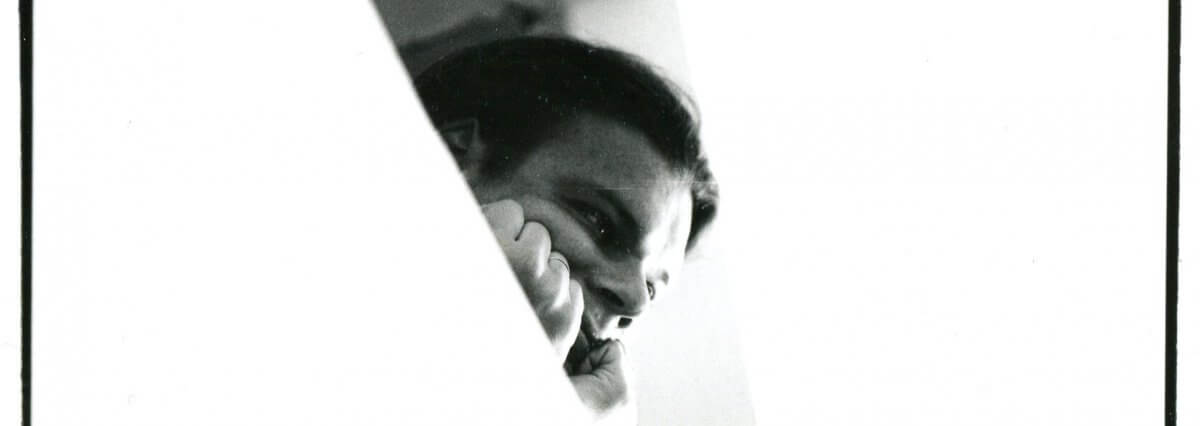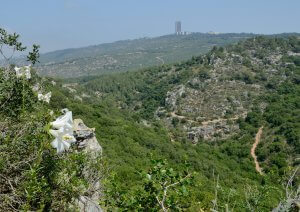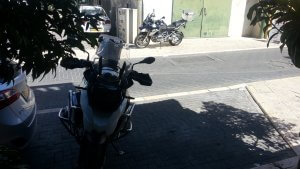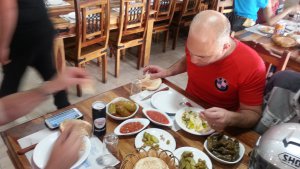Motorbike Trip to Mount Carmel National Park
By invitation of the BMW – Club Israel i made a ride to the North
visiting the park and the Al-Muhraqa at Mount Carmel
“Mount Carmel National Park (Hebrew: פארק הכרמל, Park HaKarmel) is Israel’s largest national park, extending over most of the Carmel mountain range, and containing over 10,000 hectares of pine, eucalyptus, and cypress forest. The park has numerous bicycle and walking paths, dedicated nature reserves, and over 250 archaeological sites inhabited by prehistoric humans.
The park is one of the largest open spaces of northern Israel. It is a typical example of a Mediterranean ecosystem, and includes a rich inventory of geological phenomena, prehistoric artifacts, biodiversity and landscapes. In 1996 it was recognized by UNESCO as a biosphere reserve.”
(Wikipedia)
Al Muhraqa
Text by the Discalced Carmelite Order Muhraqa Monastery
“Al Muhraqa is famous as the site of the Sacrifice of Elijah the Prophet.
It is situated at the N.E. angle of the Mt. Carmel range overlooking the plain of Esdraelon, at an altitude of 482 m. A newly opened road allows the visitor to cover the distance from Haifa to Muhraqa (about 27 kms.) in three-quarters of an hour.
The Episode is dramatically recounted in the Bible (I Kgs. 18). It takes place in the days of the wicked queen Jezebel, daughter of the king of Tyre, who sought to introduce Baal-worship into the northern kingdom, after her marriage to Ahab, king of Israel.
Elijah rose up to resist the persecution. He persuaded Ahab to assemble both people and prophets of Baal on Mount Carmel (I Kgs. 18, 21) where he challenged them to a contest.
After their failure to invoke fire from heaven on the altar and his own success, the false prophets are seized and led down to the river Kishon (I Kgs. 18, 40).
From this detail we learn that the sacrifice took place near the Kishon. From Muhraqa to Haifa, the steepness of the mountain-side excludes the possibility of the event having taken place along the lower reaches of the Kishon.
The Jewish tradition is strongly in favour of Muhraqa. Rabbi Benjamin of Tudela (about 1165) mentions the site of Elijah’s altar on Mount Carmel. Rabbi Jacob of Paris made a visit to the site. They report the existence there of an ancient monument of twelve stones representing the altar of Elijah. Many Christians, including Carmelite travellers from the 17th century onwards, verify the fact. The twelve stones disappeared later, between 1830 and 1850.
The site of the present chapel was formerly occupied by an oratory built of large cut-stones. Rabbi Jacob of Paris (1228) reports that Muslims used to visit the oratory and light candles in honour of Elijah. The building probably dated from pre-Crusader times. If fell into ruin and was replaced by the actual chapel (1883).
The site has been owned by the Carmelite Order for over a hundred years. Recently the chapel was modernized and an altar of twelve stones was erected in memory of the twelve stones used by Elijah to construct his altar according to the Bible (I Kgs, 18, 31).
On the slope leading down to the main road is to be found Bir el-Muhra-qah, which may have furnished the water for the Sacrifice.
Chirbet-ed-Dawabe is close to Muhraqa (near the parking-place): ruins from the Byzantine period have been found on the surface.
Sumaka, farther off, is the site of an extensive Jewish town also from Byzantine times. It is possible that Jews colonized the place because of its proximity to the site of Elijah’s Sacrifice.”
Rest in a drusian restaurant.



